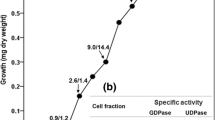Abstract
Candida albicans (C. albicans) is a fungal pathogen that causes infections of the wet body surfaces and the blood in immunocompromised patients or individuals with imbalanced microflora. Since the cases of clinically meaningful candidosis are on the rise, efficient C. albicans therapy is in a high demand. Informed drug design requires well-characterized C. albicans targets, including these aimed at disrupting its post-translational modifications. C. albicans ORF19.2286 gene encodes an ortholog of human deoxyhypusine hydroxylase (DOHH). Here, this ORF was cloned from the SC5314 strain and re-expressed in Escherichia coli as sGB1-CaDOHH construct with 6×His tag on the N-terminus of the fusion protein, then purified, and GB1-tag was removed with Tobacco etch virus (TEV) protease. Several amino acid sequence differences between C. albicans and animal DOHHs were noted, and are useful for a selection of the binding sites for antimicrobials in CaDOHH. We present the protocol for the heterologous expression and purification of C. albicans DOHH, which is suitable for further crystallization.





Similar content being viewed by others
REFERENCES
Fox E.P., Nobile C.J. 2012. A sticky situation: Untangling the transcriptional network controlling biofilm development in Candida albicans. Transcription. 3, 315–322.
Douglas L.J. 2003. Candida biofilms and their role in infection. Trends Microbiol. 11, 30–36.
Gulati M., Nobile C.J. 2016. Candida albicans biofilms: Development, regulation, and molecular mechanisms. Microbes Infect. 18, 310–321.
Rossi D., Kuroshu R., Zanelli C.F., Valentini S.R. 2014. eIF5A and EF-P: Two unique translation factors are now traveling the same road. Wiley Interdiscip. Rev. RNA. 5, 209–222.
Park M.H., Wolff E.C. 2018. Hypusine, a polyamine-derived amino acid critical for eukaryotic translation. J. Biol. Chem. 293, 18710–18718.
Wolff E.C., Wolff J., Park M.H. 2000. Deoxyhypusine synthase generates and uses bound NADH in a transient hydride transfer mechanism. J. Biol. Chem. 275, 9170–9177.
Kim Y.S., Kang K.R., Wolff E.C., Bell J.K., McPhie P., Park M.H. 2006. Deoxyhypusine hydroxylase is a Fe(II)-dependent, HEAT-repeat enzyme. Identification of amino acid residues critical for Fe(II) binding and catalysis. J. Biol. Chem. 281, 13217–13225.
Park J.H., Wolff E.C., Folk J.E., Park M.H. 2003. Reversal of the deoxyhypusine synthesis reaction. Generation of spermidine or homospermidine from deoxyhypusine by deoxyhypusine synthase. J. Biol. Chem. 278, 32683–32691.
Sievert H., Pallmann N., Miller K.K., Hermans-Borgmeyer I., Venz S., Sendoel A., Preukschas M., Schweizer M., Boettcher S., Janiesch P.C., Streichert T., Walther R., Hengartner M.O., Manz M.G., Brummendorf T.H., et al. 2014. A novel mouse model for inhibition of DOHH-mediated hypusine modification reveals a crucial function in embryonic development, proliferation and oncogenic transformation. Dis. Model. Mech. 7, 963–976.
Han Z., Sakai N., Bottger L.H., Klinke S., Hauber J., Trautwein A.X., Hilgenfeld R. 2015. Crystal structure of the peroxo-diiron(III) intermediate of deoxyhypusine hydroxylase, an oxygenase involved in hypusination. Structure. 23, 882–892.
Cano V.S., Medrano F.J., Park M.H., Valentini S.R. 2010. Evidence for conformational changes in the yeast deoxyhypusine hydroxylase Lia1 upon iron displacement from its active site. Amino Acids. 38, 479–490.
Park J.H., Aravind L., Wolff E.C., Kaevel J., Kim Y.S., Park M.H. 2006. Molecular cloning, expression, and structural prediction of deoxyhypusine hydroxylase: A HEAT-repeat-containing metalloenzyme. Proc. Natl. Acad. Sci. U. S. A. 103, 51–56.
Weir B.A., Yaffe M.P. 2004. Mmd1p, a novel, conserved protein essential for normal mitochondrial morphology and distribution in the fission yeast Schizosaccharomyces pombe. Mol. Biol. Cell. 15, 1656–1665.
Leonhard M., Zatorska B., Moser D., Schneider-Stickler B. 2019. Growth media for mixed multispecies oropharyngeal biofilm compositions on silicone. Biomed. Res. Int. 2019, 8051270.
Saitou N., Nei M. 1987. The neighbor-joining method: a new method for reconstructing phylogenetic trees. Mol. Biol. Evol. 4, 406–425.
Felsenstein J. 1985. Confidence limits on phylogenies: an approach using the bootstrap. Evolution. 39, 783–791.
Jones D.T., Taylor W.R., Thornton J.M. 1992. The rapid generation of mutation data matrices from protein sequences. Comput. Appl. Biosci. 8, 275–282.
Kumar S., Stecher G., Tamura K. 2016. MEGA7: Molecular Evolutionary Genetics Analysis version 7.0 for bigger datasets. Mol. Biol. Evol. 33, 1870–1874.
Bogomolovas J., Simon B., Sattler M., Stier G. 2009. Screening of fusion partners for high yield expression and purification of bioactive viscotoxins. Protein Exp. Purif. 64, 16–23.
Skrzypek M.S., Binkley J., Binkley G., Miyasato S.R., Simison M., Sherlock G. 2017. The Candida Genome Database (CGD): Incorporation of Assembly 22, systematic identifiers and visualization of high throughput sequencing data. Nucleic Acids Res. 45, D592–D596.
Schein C.H., Noteborn M.H.M. 1988. Formation of soluble recombinant proteins in Escherichia coli is favored by lower growth temperature. Nat. Biotechnol. 6, 291–294.
Funding
This work was supported by the Russian Science Foundation grant no. 20-65-47031.
Author information
Authors and Affiliations
Corresponding authors
Ethics declarations
Conflict of interests. The authors declare that they have no conflicts of interest.
Statement on the welfare of humans or animals. This article does not contain any studies involving humans or animals performed by any of the authors.
Additional information
The text was submitted by the author(s) in English.
Abbreviations: CRB, Cell Resuspension Buffer; GB1, B1 domain of streptococcal protein G; DHS, deoxyhypusine synthase; DOHH, deoxyhypusine hydroxylase; TEV, Tobacco etch virus; PAGE, polyacrylamide gel electrophoresis; aa, amino acids.
Supplementary Information
Rights and permissions
About this article
Cite this article
Agboigba, E., Kuchaev, E., Garaeva, N. et al. ORF19.2286 Gene: Isolation and Purification of Deoxyhypusine Hydroxylase from the Human Pathogenic Yeast Candida albicans. Mol Biol 56, 269–275 (2022). https://doi.org/10.1134/S0026893322020029
Received:
Revised:
Accepted:
Published:
Issue Date:
DOI: https://doi.org/10.1134/S0026893322020029




